November 9, 2022
A Closer Look: Black Immigrants to Virginia’s Economy and Communities
Black immigrants living in Virginia are vital to the state’s economy and communities, helping to enrich and sustain communities during good times and hard times. Many are highly educated, and most have lived in the United States for many years.
A closer look at the demographics and experiences of Black immigrants in Virginia using the most recent available data, which is from before the COVID-19 pandemic and recession, shows there are significant differences as well as shared experiences among Black immigrants from different regions, non-Black immigrant Virginians, and U.S.-born Black Virginians. This report documents some of the significant cultural and economic contributions Black immigrants make to the commonwealth and provides critical context for current conversations and addressing the ongoing barriers that Black immigrants face.

The Diverse Origins of Black Immigrants
Black Virginians who are immigrants to the United States moved here from a wide range of countries. About 124,000 foreign-born Black individuals called Virginia home in 2019, up from about 86,000 in 2007. That is 12% of all foreign-born people living in Virginia and 7% of all Black people living in Virginia. Virginia is home to over 30,000 Black Ethiopian immigrants, who make up nearly one-fourth of all Black immigrants in the state. Ghana is the next most common place of birth for Black immigrants in Virginia (14,000), followed by Jamaica (11,000). Between 3,000 and 5,000 Black immigrant Virginians each were born in Nigeria, Sierra Leone, Sudan, Trinidad and Tobago, and Haiti (in descending size order). At the regional level, more than one-third of Black immigrants in Virginia were born in East Africa, nearly one-quarter in West Africa, and one-fifth in the Caribbean (including the West Indies).
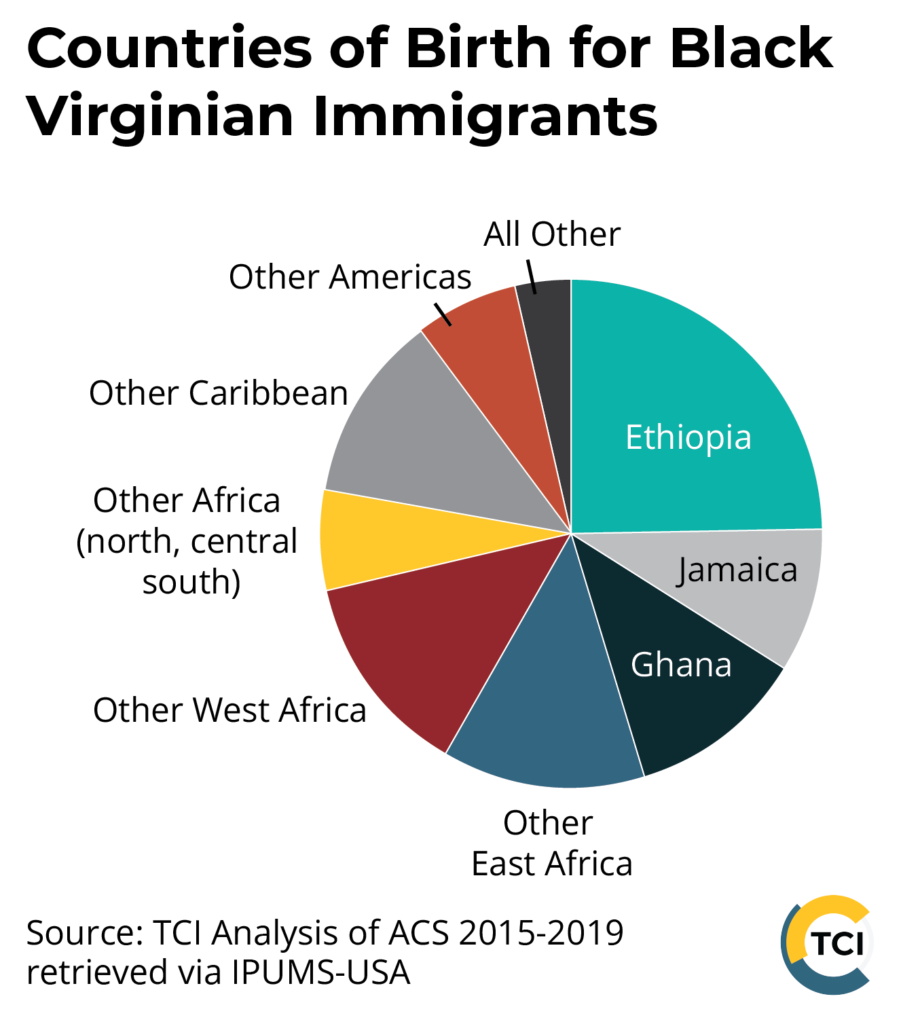
The diversity of Black immigrants in Virginia is very different from the United States as a whole, where the Caribbean is the place of birth for nearly half of immigrants who self-identify as Black, with Jamaica and Haiti being the most common birthplaces.
Approximately two-thirds of the state’s Black immigrants live in Northern Virginia. More than 13% live in the Virginia Beach/Hampton Roads metro area, and nearly 9% live in the Richmond metro area. Smaller numbers of Black immigrants also live in smaller metro areas in Virginia, particularly the Roanoke area, and in rural Virginia.
Long-term Residency Shows Commitment to Life in the U.S.
Many of Virginia’s Black immigrants have been living in the United States for a long time. Roughly 1 in 3 Black immigrants in Virginia have resided in the U.S. for at least 20 years, providing the opportunity to put down roots and adapt their job skills to the needs of their communities. Immigrants from Jamaica and other Caribbean countries are particularly likely to have been in the United States for many years, with 52% of Black Virginians born in the Caribbean living in the United States for more than 20 years.
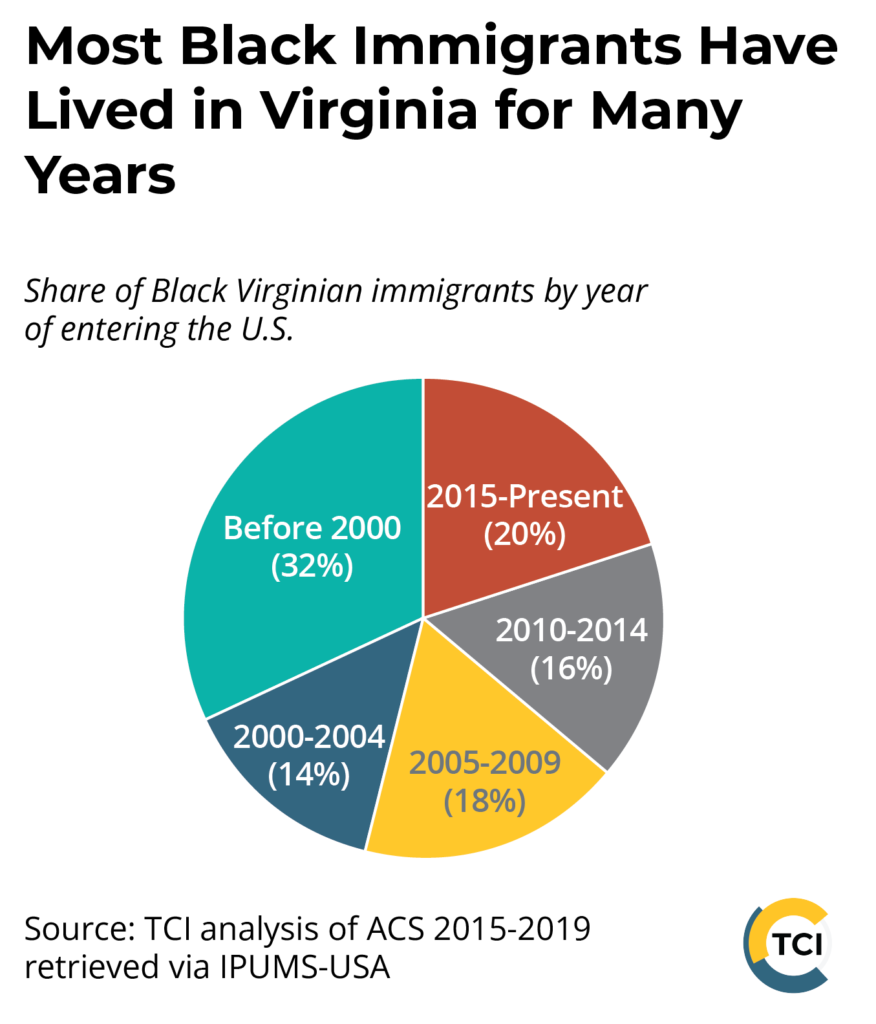
The relatively long period of time that many Black immigrant Virginians have been living in the United States means many have sufficient years of residency to become naturalized citizens. In addition to many years of residence, the process usually requires passing a U.S. history, culture, and government test. A majority of foreign-born Black Virginians are naturalized U.S. citizens (60%). Unsurprisingly, citizenship rates are highest for communities with the longest lengths of tenure in the United States, with two-thirds of Caribbean-born Black Virginians holding citizenship status. However, even among Black immigrants from Ghana, a community with many newer residents of the United States, over 60% are naturalized U.S. citizens. Specific status information is not available in Census data for non-citizen immigrants, but it is likely that these Virginians hold a range of statuses, including lawful permanent residency, temporary visas, refugee and asylum status, temporary protected status, student visas, and those who are undocumented. Many Virginia families include individuals with a variety of immigration statuses, so public policies that are inclusive of individuals with a range of immigration statuses, including those without work authority, can also help their family members, including U.S. citizens.
Economic Contributions of Black Immigrant Virginians
In addition to being committed members of Virginia communities, foreign-born Black Virginians make significant contributions to the state’s economy. A majority of working-age Black immigrants (96)% are currently employed, a share that is on par with that of other immigrant Virginians (96%) and non-immigrant Virginians (95%).
Most Black immigrants living in Virginia are of prime working age, which helps contribute to their high employment rates. More than three-quarters of foreign-born Black residents of Virginia are between the ages of 25 and 65, similar to other foreign-born residents of Virginia (74%) and significantly more than the share of non-immigrant Virginians (51%).
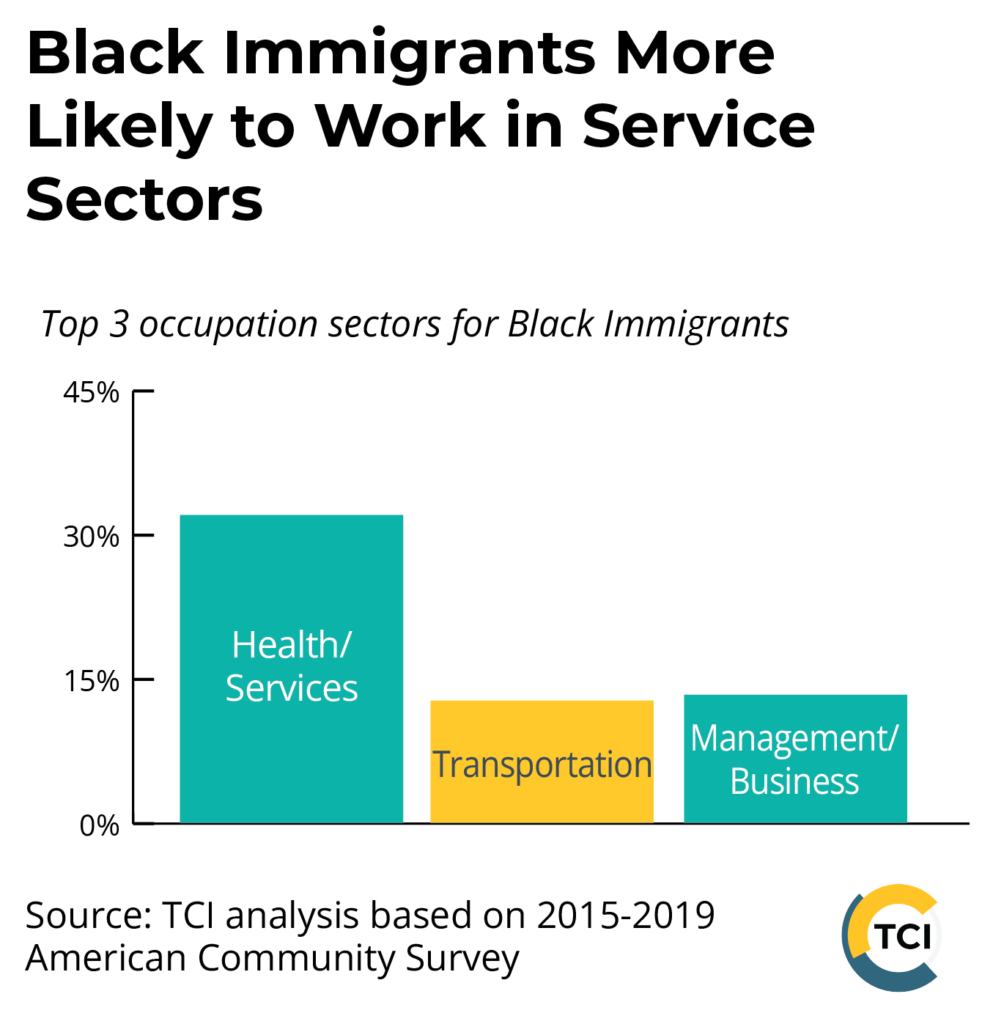
Black immigrants work in every major Virginia industry and are particularly important for Virginia’s health care and service sectors, representing 32% of Black immigrants in Virginia working in this critical sector, compared to U.S.-born Virginians (22%). Ghanaian- and other West African-born Black Virginians are particularly likely to work in the health care and service sectors, accounting for 31% of Black immigrants working in these fields. Black immigrants are also more likely than other Virginians to work in the transportation and warehousing sector, while being less likely than other Virginians to work in the construction sector.
In addition to working in all of Virginia’s major industries, Black immigrants are also important members of Virginia’s small business community. Over 3,300 self-employed Black immigrant Virginians own incorporated businesses. That is just over 1 in every 40 Black immigrants — slightly higher than the rate for U.S.-born Virginians but a little lower than that of non-Black immigrants.
Big Obstacles: Income, Language, Housing Affordability, and Health Insurance
Despite making important economic contributions to Virginia, Black immigrants and their families face significant economic barriers.
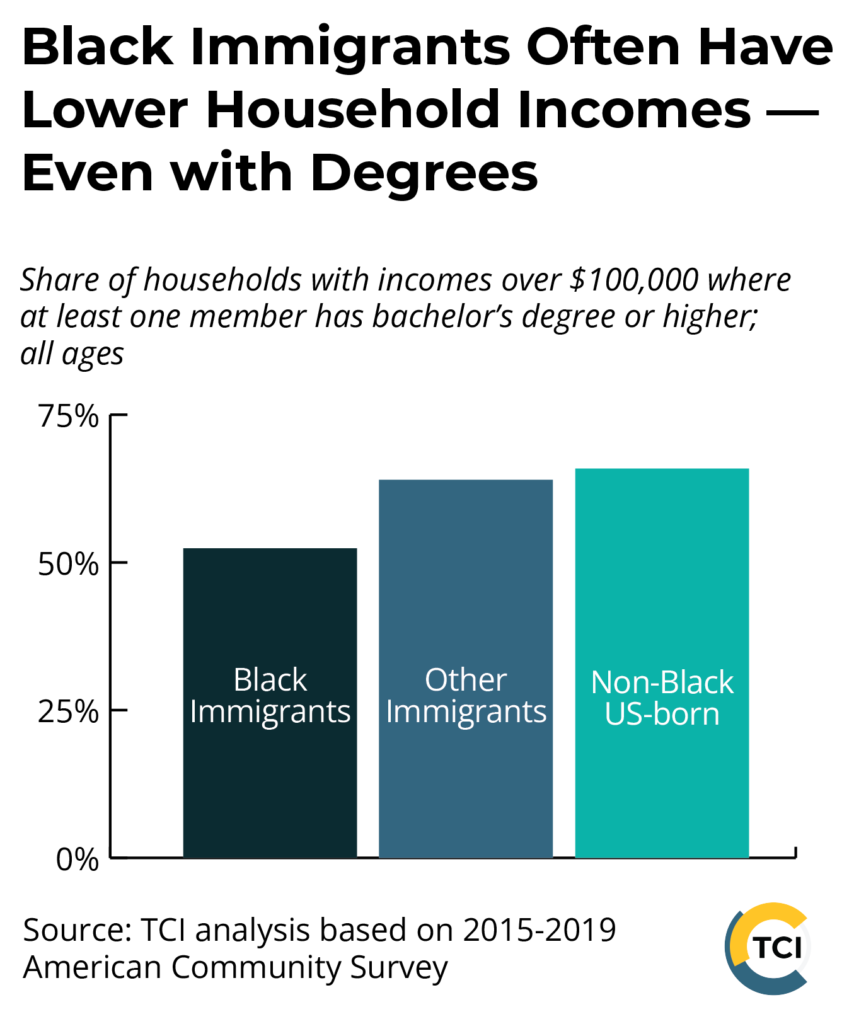
Foreign-born Black Virginians typically have high levels of educational attainment, yet many are paid less than other Virginians with similar levels of education. Over one-third of foreign-born Black adults over the age of 24 have a bachelor’s degree or higher, while just 11% have less than a high school education. These rates are similar to those of U.S.-born Virginians, but differs from Virginia’s non-Black immigrant community. Yet college-educated Black immigrant Virginians have lower individual incomes than other college-educated U.S.-born Virginians and college-educated immigrants. If we look at adults in their prime working years (age 25-65) with only a bachelor’s degree, only 46% of Black immigrant Virginians have personal incomes above $100,000 which is comparable to 49% of U.S.-born Black Virginians, but less than the 60% of non-Black immigrant Virginians and 66% of U.S.-born non-Black Virginians. Black immigrants with bachelor’s degrees are also more likely to have personal incomes under $50,000 (22%), which is slightly higher than U.S.-born Black Virginians (19%) and non-Black immigrant Virginians (15%), but more than twice the amount of U.S.-born non-Black Virginians (10%).
As a result of lower individual incomes despite high educational attainment levels, foreign-born Black Virginians tend to live in households with lower incomes than other Virginia households. This fact is particularly striking given that most Black immigrants in Virginia reside in the high-cost Northern Virginia area. In Northern Virginia, 39% of Black immigrants live in households with incomes above $100,000, a rate similar to U.S.-born Virginians across the state (44%), but significantly less than U.S.-born Virginians living in the region (66%).
Several factors likely contribute to Black immigrant Virginians’ lower returns on education. Language is a factor for some though far from all Black immigrants, as is trouble getting overseas professional credentials recognized and possibly more limited social and business networks. However, it is hard to discount the role that racial discrimination plays in the American labor market. The existence of discrimination against Black Americans is well documented, and it is likely that this discrimination also extends to Black immigrants. For example, research using matched-pair tests shows employers strongly favor non-Hispanic white applicants over Black applicants.1 Black and Latino applicants were also more likely to be channeled to jobs that had less customer interaction and more manual labor.2 Other research shows that Black workers are paid less than non-Hispanic white workers even within the same private-sector occupations. These differences remain even after controlling for education, experience, region, and marital status.3
Despite playing a key role in businesses and the community,
Black immigrants face many barriers to fully participating in their communities.
Most Black immigrants in Virginia have high levels of English fluency, but lack of language access is still a significant barrier to full participation for some. Just over three-fourths (77%) of Black immigrants in Virginia report speaking only English or speaking English “very well,” and another 15% report speaking English “well.” However, for the 8% of Black immigrants in Virginia (about 9,400 people) who do not speak English at least very well or at all, there are significant barriers to accessing the same services as English-speaking individuals. To the extent that non-English materials and interpreters are widely available in Virginia, these services are most readily available in Spanish, and many Black immigrants were born in non-Spanish-speaking countries. About one-third of the 9,400 Black immigrants who are less than proficient in English were born in Ethiopia, where Amharic and Oromo are the most common languages, but over 100 languages are spoken.4
One way to make it more likely that everyone can find a job that matches their skills and abilities would be to make sure immigrant workers who do not speak English “very well” have access to language training or language-sensitive work programs. Virginia should structure workforce development and adult education programs in ways that make them more accessible to workers with less proficiency in English. Virginia can also use tools like interpretation lines to make sure everyone, including those who speak less common languages, can navigate community and public services.
Low incomes present particular challenges for Black immigrant workers and families in Virginia because so many live in the high-cost Northern Virginia area, where rent, child care, and other living costs far outpace national averages. As a result, almost 4 in 10 Black immigrants live in households that pay more than 30% of their income toward housing costs — the rate that most experts consider unaffordable. By comparison, just 25% of all U.S.-born Virginians and 34% of non-Black immigrants live in households that pay that high a share. Together, relatively low incomes, high housing costs, and being less likely to have inherited a property in Virginia may explain why only 45% of foreign-born Black Virginians live in owner-occupied homes, compared to two-thirds of U.S.-born Virginians.

Another significant challenge is that, despite high employment levels, 19% of foreign-born Black Virginians have no form of health insurance, lower than the rate for other immigrants (22%) but much higher than the rate for U.S.-born Virginians who have no health insurance (7%). When we look across the diaspora, particularly among the African continent and the Caribbeans, we see high rates of uninsured immigrants, with 19% of Black immigrants who were born in Africa and 15% of Black immigrants who were born in Jamaica or elsewhere in the Caribbean lacking health insurance.
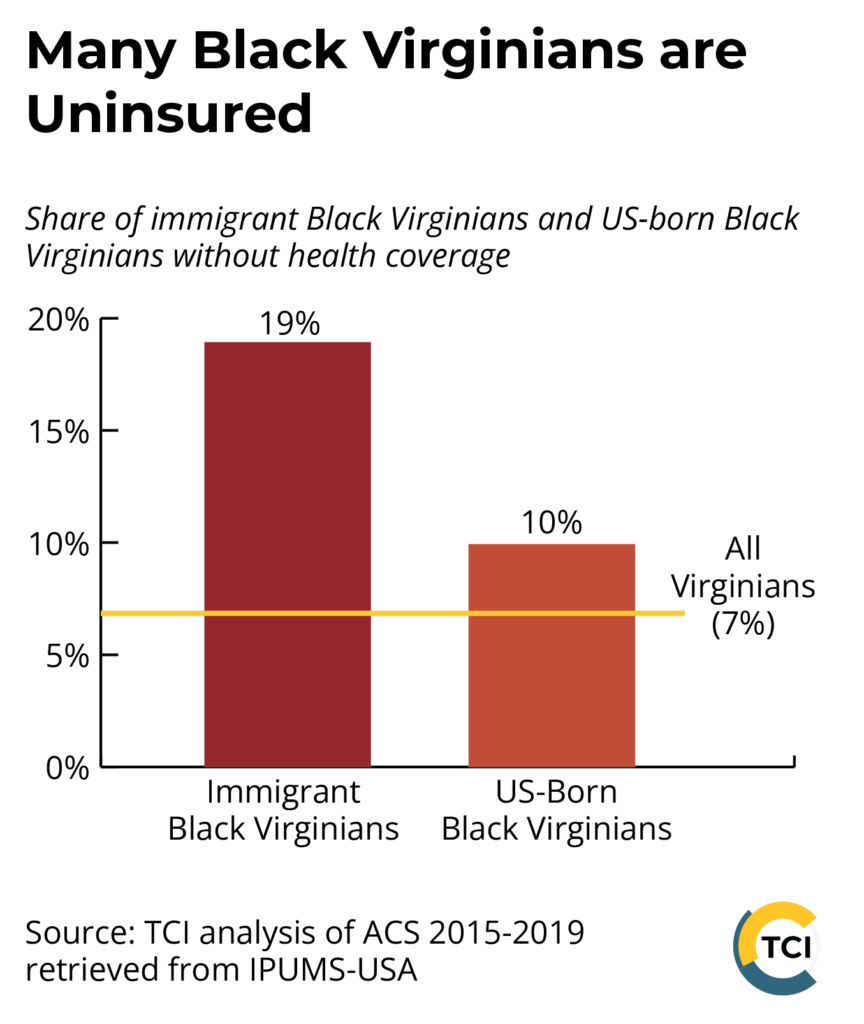
Black immigrants experience very low levels of health coverage in part because, until very recently, Virginia imposed higher limits than the federal government on access to public coverage for lawfully present immigrants, and the most recently available Census data does not include the impact of removing that exclusion. Furthermore, some groups of immigrants remain excluded from public health insurance coverage. Undocumented immigrants are ineligible for full Medicaid coverage and are barred from buying health coverage on the Affordable Care Act individual marketplace. As a result, many non-citizens are still likely to be uninsured. Emergency Medicaid is available to reimburse hospitals for certain emergency procedures for people who are ineligible for Medicaid due to immigration status, but this is a far cry from comprehensive health insurance.
The pandemic both highlighted and heightened the barriers and unequal outcomes that Black immigrants face across various institutions. Black immigrants around the country have been denied residency and detained in the U.S. at disproportionate rates since the start of the pandemic,5 facing greater exposure to COVID due to overcrowded and often unsanitary detention centers. Black immigrants are more likely to work in essential occupations, thus placing Black immigrants on the frontlines of the pandemic and at an increased risk.6 The economic decline of the U.S. in the wake of the pandemic also impacted the native countries of Black immigrants. With the stress of trying to navigate the COVID crisis, families and the broader economy in these countries are under great pressure and have had to rely significantly on remittances, or what little of it they can get.7 As the state continues to recover from the pandemic, lawmakers should take care to consider how Black immigrants in particular can best be served in these recovery efforts.
Methodology
This report is based on estimates from the Census Bureau’s American Community Survey (ACS). The data for immigrants includes everyone born in a foreign country, regardless of immigration status. The ACS includes undocumented immigrants, but undercounts them by about 10%. The Migration Policy Institute incorporates that undercount in their estimate that there are 14,000 undocumented Virginians who were born in Africa or the Caribbean,8 which are the most common regions of origin for Black immigrants living in Virginia.
The report defines Black immigrants as all foreign-born residents of Virginia who self-identify as Black or African American, including those who identify with two or more races including Black or African American. Individuals from Puerto Rico and other U.S. territories, and those born abroad of U.S.-citizen parents, are not considered foreign-born. Although this report focuses on Black immigrants as a whole, in places it will dive into differential experiences for immigrants from different regions.
All data is 2015-2019 average annual data. This report does not adjust for the potential undercount of undocumented immigrants because we do not have sufficient information to provide accurate adjustments.
Endnotes
- Pager, D., Western, B., and Bonikowski, B., “Discrimination in a Low-Wage Labor Market: A Field Experiment,” Institute for the Study of Labor Discussion Paper, Oct 2009
- Ibid.
- Grodsky, E. and Pager, D., “The Structure of Disadvantage: Individual and Occupational Determinants of the Black-White Wage Gap,” American Sociological Review, 2001
- Crummey. D., “Federal Democratic Republic of Ethiopia,” Brittanica, Oct 2022
- Gomez, J. and Meraz, V., “Immigrant Families during the Pandemic: On the Frontlines but Left Behind,” CLASP, Feb 2021
- Clergé, O., and Edwards, Z., “Immigrants: The Pandemics of Racism, Nativism, and Transnational Crises,” Equity Research Institute, Apr 2021
- Ibid.
- Migration Policy Institute (MPI) analysis of U.S. Census Bureau data from the 2015-19 American Community Survey (ACS) pooled, and the 2008 Survey of Income and Program Participation (SIPP), drawing on a methodology developed in consultation with James Bachmeier of Temple University and Jennifer Van Hook of The Pennsylvania State University, Population Research Institute https://www.migrationpolicy.org/programs/us-immigration-policy-program-data-hub/unauthorized-immigrant-population-profiles
